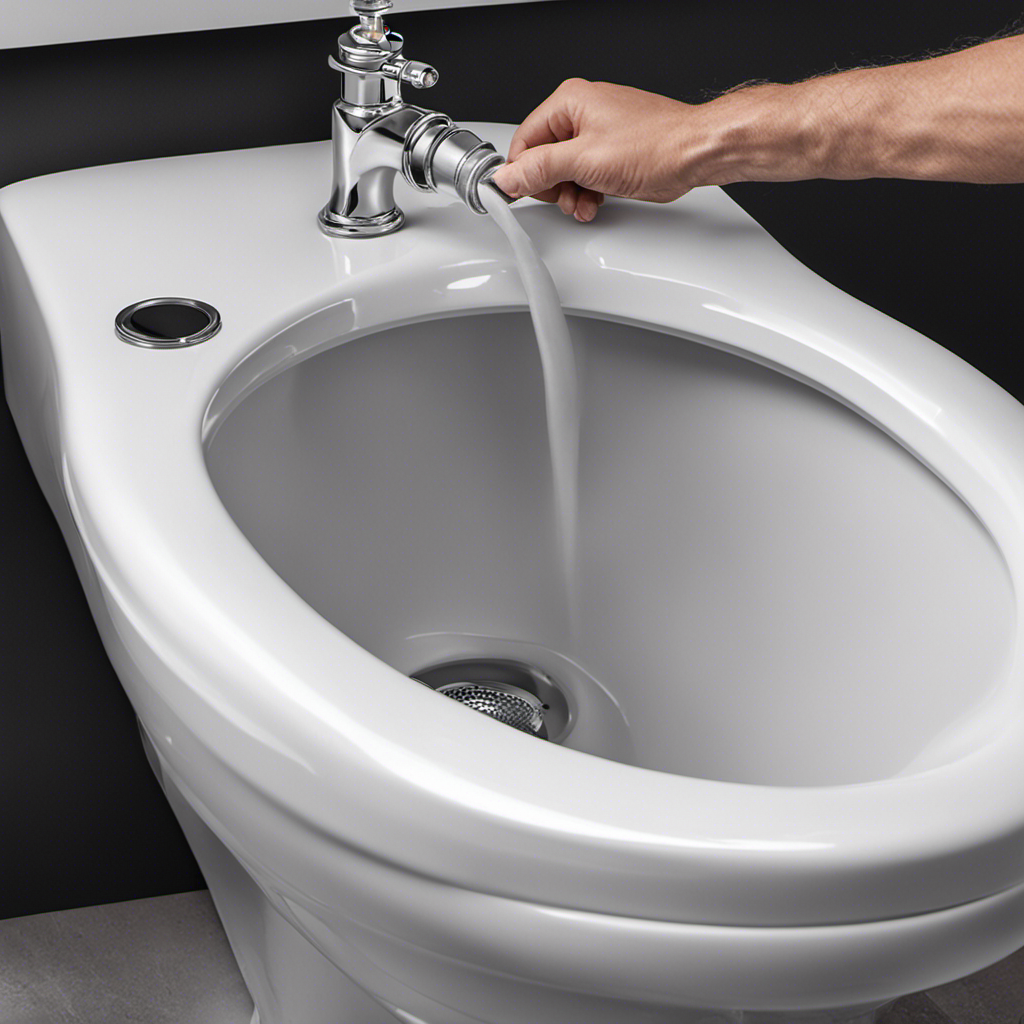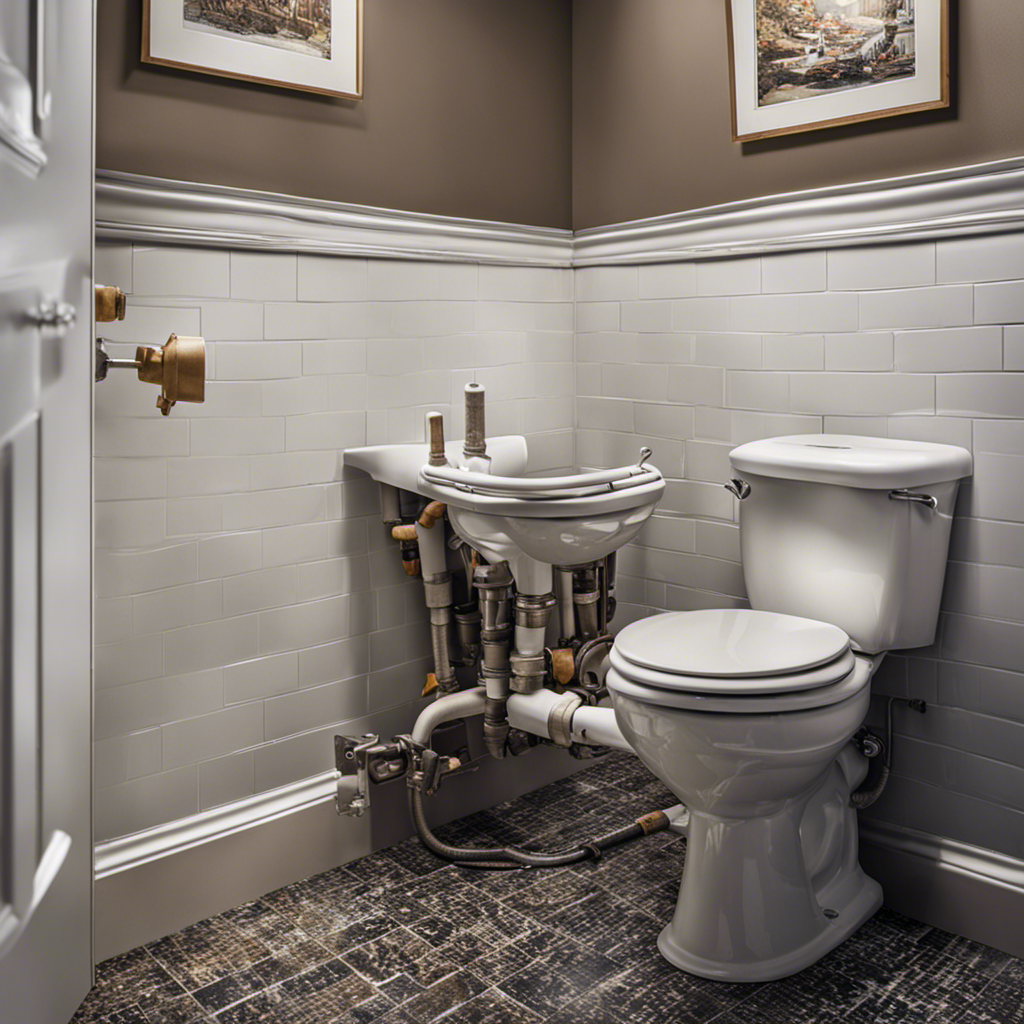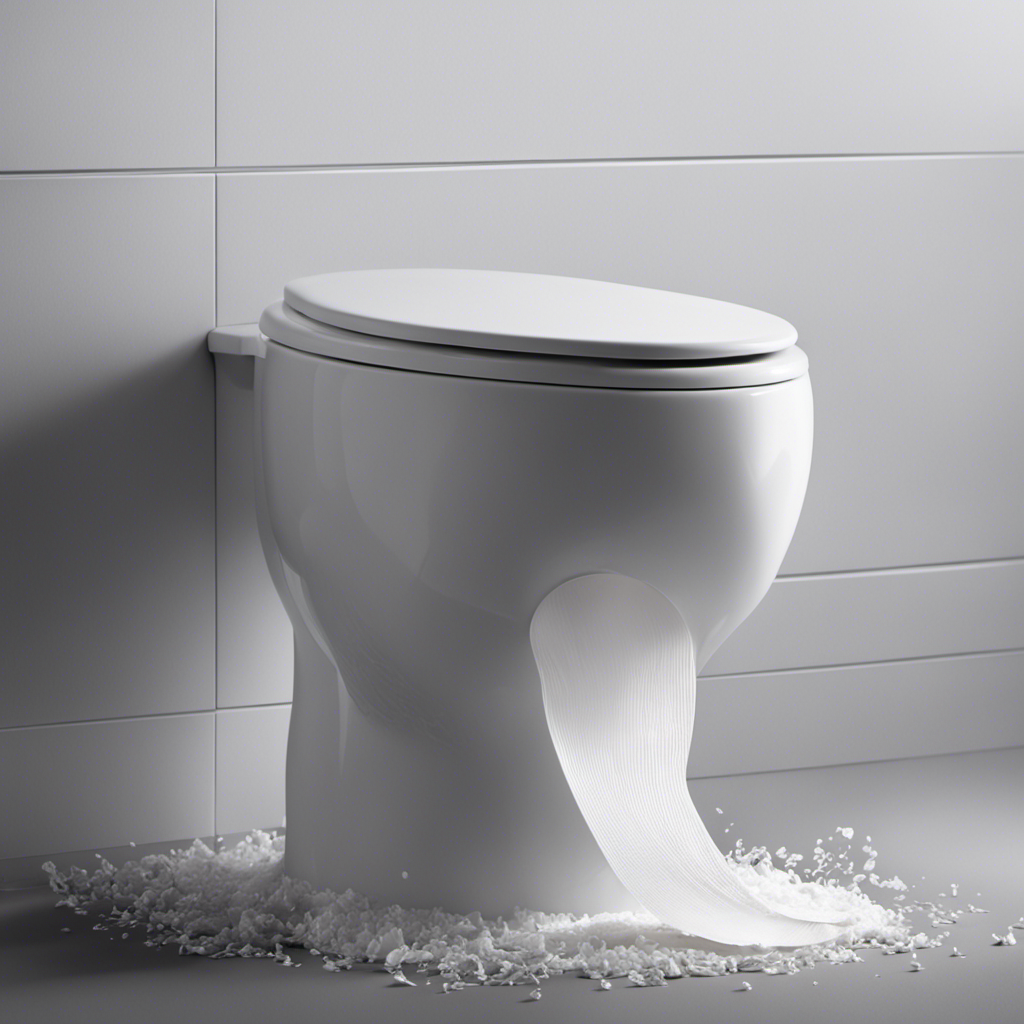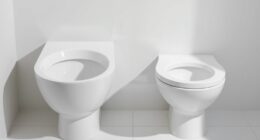As I dive into the murky waters of slow toilet flushing, I am reminded of the saying, ‘A smooth-flowing toilet is a peaceful oasis in the chaos of daily life.’
If you find yourself facing the frustration of a sluggish flush, fear not! In this article, I will guide you through the steps to diagnose and fix common causes of slow flushing.
With a little technical know-how and a few adjustments, your toilet will be back to its efficient, powerful self in no time.
Key Takeaways
- Clogs in the pipes or buildup of toilet paper, debris, or mineral deposits can cause slow toilet flushing.
- Checking the water supply for low water pressure or valve blockage can help identify the cause of slow flushing.
- Valve blockage can occur due to worn-out or misaligned flapper, clogged mechanisms, mineral deposits, or foreign objects.
- Adjusting the flapper and cleaning the flush valve can improve flushing efficiency and restore normal water flow.
Common Causes of Slow Toilet Flushing
If your toilet is flushing slow, one common cause could be a clog in the pipes. When there is a clog, the flow of water from the toilet tank to the toilet bowl is restricted, resulting in a sluggish flush. The clog can occur due to various reasons, such as a buildup of toilet paper, foreign objects, or even mineral deposits.
To fix this issue, it is essential to identify the location of the clog and remove it. This can be done by using a plunger or a toilet auger to dislodge the obstruction. Once the clog is cleared, the water flow should improve, and the toilet should flush normally again.
Now, let’s move on to the next step, which involves checking the water supply.
Checking the Water Supply
When troubleshooting toilet flushing issues, it’s important to consider water pressure as a potential cause. Low water pressure can result in weak or incomplete flushes, leading to a slow toilet flushing.
Additionally, valve blockage can also contribute to poor flushing performance. Accumulated debris or mineral deposits can obstruct the flow of water, affecting the effectiveness of the flush.
Water Pressure Issues
The first thing you should check is if the water pressure in your house is too low. Low water pressure can affect the performance of your toilet bowl and cause slow flushing.
To determine if this is the issue, you can start by checking the water pressure at different faucets in your house. Use a water pressure gauge to measure the pressure and compare it to the optimal range of 40-60 psi. If the pressure is below this range, you may need to contact plumber services to inspect and fix the water pressure issue.
Low water pressure can be caused by various factors such as a clogged pipe or a faulty pressure regulator. Addressing this problem will help improve the flushing efficiency of your toilet.
Now, let’s move on to the potential of valve blockage.
Valve Blockage Potential
Now, let’s explore the possibility of a valve being blocked. When it comes to a slow-flushing toilet, a blocked valve is a common culprit. Here are a few things to consider:
-
Toilet Flapper: The flapper is the rubber seal that controls the flow of water from the tank to the bowl. If it’s worn out or not properly aligned, it can restrict the water flow, causing a slow flush.
-
Toilet Tank: Inside the tank, there are various valves and mechanisms that regulate the water flow. If any of these components are clogged or malfunctioning, it can result in reduced flushing power.
-
Mineral Buildup: Over time, mineral deposits can accumulate in the valves and pipes, obstructing the water flow. Regular cleaning and maintenance can help prevent this issue.
-
Foreign Objects: Sometimes, objects like toys or feminine hygiene products can accidentally find their way into the toilet tank, causing blockages that lead to slow flushing.
Adjusting the Flapper
To fix the slow flushing of your toilet, you should start by adjusting the flapper. The flapper is a crucial component that controls the water flow from the tank into the bowl. Over time, it can become misaligned or worn out, leading to inefficient flushing.
To adjust the flapper, first, locate the flapper chain and ensure it has proper tension. If it’s too loose, it may not lift the flapper fully, causing reduced water flow.
Next, check the flapper for any signs of damage or deterioration. If it’s worn out or leaking, a flapper replacement may be necessary. Simply remove the old flapper and install a new one, ensuring a secure fit.
Cleaning the Flush Valve
Now that we’ve adjusted the flapper, let’s move on to cleaning the flush valve. This is another common cause of slow toilet flushing. The flush valve is responsible for releasing water from the tank into the bowl, and if it’s dirty or clogged, it can impede the flushing process.
Here are some troubleshooting tips and a simple cleaning method to help you fix this issue:
- Start by turning off the water supply to the toilet.
- Flush the toilet to drain out any remaining water in the tank.
- Use a brush or a scrub pad to gently scrub the flush valve, removing any mineral deposits or debris.
- Once clean, turn on the water supply and test the flush. If it’s still slow, you may need to repeat the cleaning process or seek professional help.
Clearing Clogs in the Drain
If you’re experiencing a blockage in your drain, there are a few methods you can try to clear it. One of the most common unclogging methods is using a plunger. This tool creates suction and pressure to dislodge the blockage. Start by covering the drain opening with the plunger and pushing down firmly, then pulling up quickly. Repeat this motion several times until the water starts to drain properly.
Another method you can try is using a drain snake. This flexible tool can reach deep into the drain to break up and remove the clog. Insert the snake into the drain and twist it while pushing it in and out.
If these methods don’t work, it may be time to call a professional plumber who has the expertise and specialized equipment to tackle even the toughest clogs.
Upgrading the Toilet’s Flushing Mechanism
As a professional plumber, I’ve encountered many toilets with inefficient flush valves that can cause poor flushing performance.
In order to improve the flushing mechanism, there are several options to consider. One option is installing a dual flush system that allows users to choose between a full flush and a partial flush. This can help save water by using less for liquid waste and more for solid waste.
Another option is incorporating water-saving mechanisms, such as adjustable water volume settings. This allows users to control the amount of water used for each flush, helping to conserve water without compromising flushing power.
Pressure-assisted flush systems are also a great option. These systems use air pressure to provide a strong and efficient flush, ensuring that waste is properly removed from the toilet bowl.
Efficient Flush Valve
To improve the efficiency of your toilet’s flush valve, you should try adjusting the water level in the tank. This simple adjustment can help optimize the flushing power and prevent slow or incomplete flushes. Here are some steps to follow:
- Locate the water supply valve near the base of the toilet and turn it off.
- Remove the toilet tank lid and locate the toilet flapper, which is responsible for releasing water into the bowl.
- Adjust the water level by either lowering or raising the float, which controls the water level in the tank.
- Test the flush by flushing the toilet a few times and observe the water flow.
Dual Flush Options
Consider exploring dual flush options for your toilet to have more control over your water usage.
Dual flush toilets offer the convenience of two different flushing options: a full flush for solid waste and a half flush for liquid waste.
By using the appropriate flush option, you can significantly reduce water consumption and contribute to water conservation efforts.
With a dual flush toilet, you can easily adjust the water level to suit your needs. The water level adjustments can be made using the toilet flush handle, allowing you to customize the flush to effectively remove waste while minimizing water usage.
This innovative solution not only saves water but also helps in reducing your utility bills.
Upgrade to a dual flush toilet for a more efficient and environmentally-friendly bathroom experience.
Water-Saving Mechanisms
After discussing the various options for dual flush toilets, let’s now delve into the importance of water conservation and the different mechanisms available to save water in your toilet.
When it comes to toilet water usage, it’s essential to implement effective water conservation strategies. Here are a few mechanisms that can help:
-
Dual Flush Systems: These systems allow users to choose between a full flush for solid waste and a reduced flush for liquid waste, saving water with each use.
-
Water-Saving Flush Valves: These valves are designed to release a specific amount of water per flush, reducing water consumption without compromising performance.
-
Adjustable Flapper Valves: By adjusting the flapper valve, you can regulate the amount of water released during each flush, minimizing water waste.
-
Flush Volume Reducers: These devices can be installed inside the toilet tank to reduce the volume of water used per flush, promoting water conservation.
Frequently Asked Questions
Can a Slow Flushing Toilet Be Fixed Without Upgrading the Flushing Mechanism?
Yes, a slow flushing toilet can be fixed without upgrading the flushing mechanism. By checking the toilet bowl for clogs and adjusting the water pressure, you can improve the flushing performance.
Is It Necessary to Turn off the Water Supply Before Adjusting the Flapper?
Toilet flapper adjustment may require turning off the water supply for precise adjustments. This ensures proper functioning and prevents water flow during the process. It’s a necessary step to avoid any mishaps.
What Are Some Signs That Indicate a Clogged Drain in a Toilet?
Some signs of a clogged toilet drain include water backing up, slow flushing, and a gurgling sound. To unclog the drain, try using a plunger or a drain snake to remove the obstruction.
Are There Any Specific Cleaning Products Recommended for Cleaning the Flush Valve?
There are many effective cleaning products available specifically for cleaning the flush valve. These products can help remove any buildup or debris that may be causing the slow flushing issue.
Can a Slow Flushing Toilet Be a Symptom of a Bigger Plumbing Issue?
A slow flushing toilet could indicate a larger plumbing problem, such as low water pressure or a malfunctioning toilet tank. It’s important to address these issues promptly to prevent further complications.
Conclusion
Well, after spending hours tinkering with my toilet, I can confidently say that fixing a slow flushing toilet is an absolute breeze.
Just a few simple steps and you’ll have that toilet flushing like a jet engine. Who needs a plumber when you can become a DIY toilet expert?
Remember, it’s all about adjusting the flapper, cleaning the flush valve, and clearing those pesky clogs.
So go ahead, embrace your inner handyman and conquer the world of slow flushing toilets. You got this!










